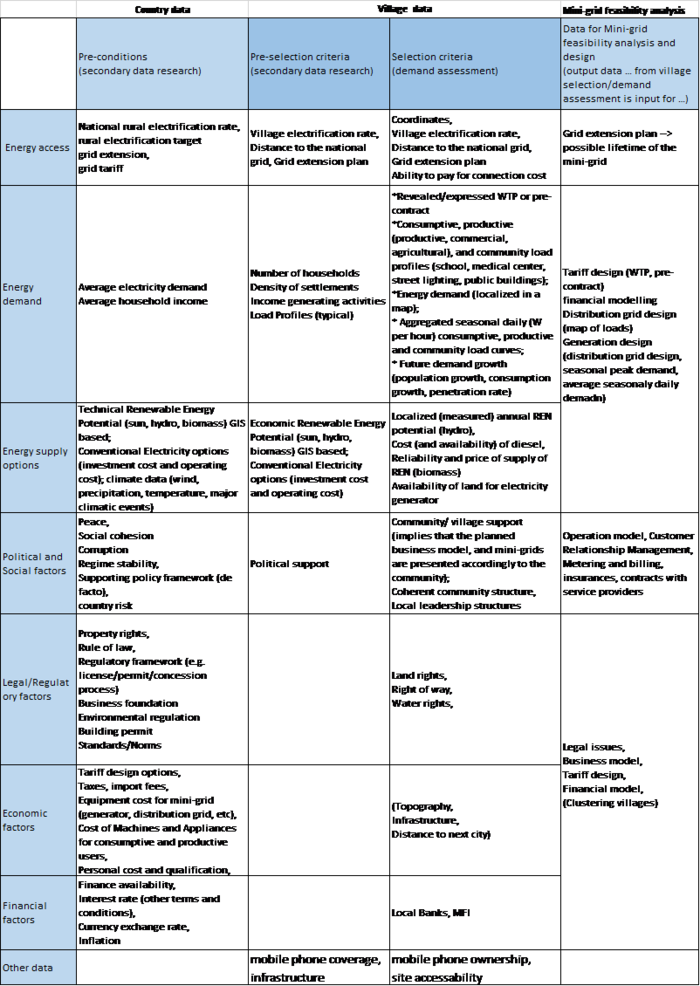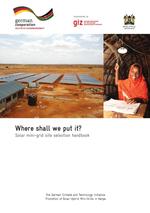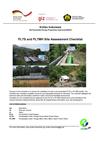Knowledge fuels change
For over a decade, Energypedia has shared free, reliable energy expertise with the world.
We’re now facing a serious funding gap.
Help keep this platform alive — your donation, big or small, truly matters!
Thank you for your support
Difference between revisions of "Site Selection for Mini-grids"
***** (***** | *****) |
***** (***** | *****) m |
||
| (19 intermediate revisions by 6 users not shown) | |||
| Line 1: | Line 1: | ||
| − | = | + | = Overview = |
| + | |||
Selection of the village(s)/site(s) for a mini-grid can be a complex multistage process that depends on various criteria. The steps and data needed in the selection process depend on the background of the mini-grid project developer. A private international project developer has different site options and different selection criteria than a national project developer, who is bound to one country, a utility, which is bound to one country and to other political obligations (e.g. a specific geographic region or specific priority customer groups), or a community mini-grid project for which the site selection process is unnecessary as it is already bound to a certain village. Further, if the perspective is not that of a project developer but that of a public institution, which wants to include mini-grids in the rural electrification planning, the village selection for mini-grids can only include information up to a certain detail level and is usually done in the rural electrification planning (and will not be further discussed here). | Selection of the village(s)/site(s) for a mini-grid can be a complex multistage process that depends on various criteria. The steps and data needed in the selection process depend on the background of the mini-grid project developer. A private international project developer has different site options and different selection criteria than a national project developer, who is bound to one country, a utility, which is bound to one country and to other political obligations (e.g. a specific geographic region or specific priority customer groups), or a community mini-grid project for which the site selection process is unnecessary as it is already bound to a certain village. Further, if the perspective is not that of a project developer but that of a public institution, which wants to include mini-grids in the rural electrification planning, the village selection for mini-grids can only include information up to a certain detail level and is usually done in the rural electrification planning (and will not be further discussed here). | ||
| − | The selection process can be split into different steps: the | + | {{Go to Top}}<br/> |
| + | |||
| + | = Site Selection = | ||
| + | |||
| + | The selection process can be split into different steps: <br/> | ||
| + | |||
| + | #the collection of pre-condition data relevant for the country selection (for international project developers) or the basic decision whether to go into the mini-grid business (for national private project developers and utilities), <br/> | ||
| + | #the gathering of pre-selection data to find the best suited villages for a detailed demand assessment (relevant for , for utilities, private project developers and the rural electrification planning),<br/> | ||
| + | #conducting a demand assessment to calculate, predict, evaluate the electricity demand of each village (for all project developers),<br/> | ||
| + | #performing a feasibility analysis which uses the assessed demand to do a pre-design of the technical layout and models the financial performance of the mini-grid (for all project developers to assess if a mini-grid is economically viable at this site/these sites), and<br/> | ||
| + | #doing an economic analysis to assess the cost-benefits of a potential system (an economic analysis is only needed in special cases for prioritizing investment, or when the appropriate level of state subsidy has to be evaluated – not included in the further discussions). | ||
The criteria in the selection process are electricity related (e.g. electricity access, electricity demand, electricity supply) or related to environmental conditions (e.g. social, economic, and financial factors) or to framework conditions (e.g. political, regulatory, and legal factors). The table below illustrates the possible criteria in the different stages. These criteria have impacts on the mini-grid feasibility, implementation and operation. The selected villages must present sufficient energy demand and sufficient collectable revenues to recover the project development costs, investment costs and operation costs and they must be supported by conductive environmental and framework conditions. | The criteria in the selection process are electricity related (e.g. electricity access, electricity demand, electricity supply) or related to environmental conditions (e.g. social, economic, and financial factors) or to framework conditions (e.g. political, regulatory, and legal factors). The table below illustrates the possible criteria in the different stages. These criteria have impacts on the mini-grid feasibility, implementation and operation. The selected villages must present sufficient energy demand and sufficient collectable revenues to recover the project development costs, investment costs and operation costs and they must be supported by conductive environmental and framework conditions. | ||
| − | The criteria presented are collected through secondary data research, evaluated through a demand assessment or calculated based on data collected and assessed. After each step only the best villages are considered for the next analyses or for the mini-grid implementation. In the end, the combined results of the demand assessment, the engineering design and the financial analysis determine the ultimate feasibility of the mini-grid project | + | The criteria presented are collected through secondary data research, evaluated through a demand assessment or calculated based on data collected and assessed. After each step only the best villages are considered for the next analyses or for the mini-grid implementation. In the end, the combined results of the demand assessment, the engineering design and the financial analysis determine the ultimate feasibility of the mini-grid project <ref name="NRECA, 2009. Guides for Electric Cooperative Development and Rural Electrification”.Retrieved from https://www.nreca.coop/wp-content/uploads/2013/07/GuidesforDevelopment.pdf">NRECA, 2009. Guides for Electric Cooperative Development and Rural Electrification”.Retrieved from https://www.nreca.coop/wp-content/uploads/2013/07/GuidesforDevelopment.pdf</ref>.<br/> |
| + | [[File:Site Selection Criteria for Mini-grids.png|border|left|700px|Site Selection for Mini-grids|alt=Site Selection Criteria for Mini-grids.png]]<div style="clear: both"></div> | ||
| + | <br/> | ||
| + | |||
| + | {{Go to Top}}<br/> | ||
| + | |||
| + | = Recommended Literature<br/> = | ||
| + | |||
| + | == NRECA (2009), “Guides for Electric Cooperative Development and Rural Electrification” == | ||
| + | |||
| + | [https://www.nreca.coop/wp-content/uploads/2013/07/GuidesforDevelopment.pdf This report] gives an excellent overview of the village selection process in module 5 “methodology for evaluating feasibility of rural electrification projects”. The process has roughly the same stages and the same names than in this document but each step is discussed in more detail. | ||
<br/> | <br/> | ||
| + | {{Go to Top}}<br/> | ||
| − | = | + | == GIZ - ProSolar Kenya (2014), “Where shall we put it? Solar mini-grid site selection handbook” == |
| − | |||
| − | This | + | [[File:GIZ2014-en-where-shall-we-put-it-kenya.pdf|thumb|right|150pxpx|Where shall we put it? Solar mini-grid site selection handbook|alt=Where shall we put it? Solar mini-grid site selection handbook]] [[:File:GIZ2014-en-where-shall-we-put-it-kenya.pdf|This handbook]], prepared by the [https://www.giz.de/en/worldwide/25332.html ProSolar project of GIZ - Kenya], can be used as a guideline by all actors in the energy sector to perform a site selection analysis for any mini-grid project, by carefully selecting the appropriate parameters that apply to their own areas of implementation. The guidelines incorporated in this handbook have been developed to assist all players in the energy sector (private sector actors, government institutions, academic institutions and development partners) in site assessment and selection. The guiding principles are based upon the findings of the assessment of 14 sites, carried out by GIZ, REA, MoEP and Kenya Power between June and October 2013 in Marsabit, Samburu and Turkana counties, in the framework of the Scaling-Up Renewable Energy Programme (SREP) for Mini-Grids. The methodology and criteria presented are different from those presented in this document and in the NRECA (2009) publication. It enables to follow an alternative approach.<br/> |
| − | + | For more information click [[:File:GIZ2014-en-where-shall-we-put-it-kenya.pdf|here]]. | |
| − | + | <br/> | |
| − | + | {{Go to Top}}<br/> | |
| − | This report presents a site identification process for hydro power mini-grid and the necessary energy potential assessment. | + | == GIZ Endev Indonesia (2014) 'Site criteria checklist' == |
| + | |||
| + | '''[[File:EnDev Indonesia Site Criteria Checklists for PLTS and PLTMH.pdf|thumb|right|100pxpx|GIZ EnDev (2014)|EnDev Indonesia Site Criteria Checklist]]''' | ||
| + | |||
| + | The [[:File:EnDev_Indonesia_Site_Criteria_Checklists_for_PLTS_and_PLTMH.pdf|purpose of the checklist]] is to assess the suitability of a site to accommodate solar powered or micro-hydro powered mini-grid. The checklist also considers available resources and anticipated demand for electricity. The checklist highlights the minimum data and information needed to make a first-level feasibility assessment. | ||
| + | |||
| + | <br/> | ||
| + | |||
| + | {{Go to Top}}<br/> | ||
| + | |||
| + | == ACE-GTZ (2009), “The GOOD & BAD of Mini Hydro Power” == | ||
| + | |||
| + | [[File:Good and bad of mini hydro power vol.1.pdf|thumb|right|100px|Good and bad of mini hydro power vol.1.pdf]] | ||
| + | |||
| + | [https://energypedia.info/images/7/77/Good_and_bad_of_mini_hydro_power_vol.1.pdf This report] presents a site identification process for hydro power mini-grid and the necessary energy potential assessment. | ||
<br/> | <br/> | ||
| − | => [[ | + | {{Go to Top}}<br/> |
| + | |||
| + | = References = | ||
| + | |||
| + | <references /><br/> | ||
| + | |||
| + | [[Category:Mini-grid]] | ||
| + | [[Category:Renewable_Energy]] | ||
| + | [[Category:Rural_Electrification]] | ||
Latest revision as of 13:24, 13 October 2016
Overview
Selection of the village(s)/site(s) for a mini-grid can be a complex multistage process that depends on various criteria. The steps and data needed in the selection process depend on the background of the mini-grid project developer. A private international project developer has different site options and different selection criteria than a national project developer, who is bound to one country, a utility, which is bound to one country and to other political obligations (e.g. a specific geographic region or specific priority customer groups), or a community mini-grid project for which the site selection process is unnecessary as it is already bound to a certain village. Further, if the perspective is not that of a project developer but that of a public institution, which wants to include mini-grids in the rural electrification planning, the village selection for mini-grids can only include information up to a certain detail level and is usually done in the rural electrification planning (and will not be further discussed here).
Site Selection
The selection process can be split into different steps:
- the collection of pre-condition data relevant for the country selection (for international project developers) or the basic decision whether to go into the mini-grid business (for national private project developers and utilities),
- the gathering of pre-selection data to find the best suited villages for a detailed demand assessment (relevant for , for utilities, private project developers and the rural electrification planning),
- conducting a demand assessment to calculate, predict, evaluate the electricity demand of each village (for all project developers),
- performing a feasibility analysis which uses the assessed demand to do a pre-design of the technical layout and models the financial performance of the mini-grid (for all project developers to assess if a mini-grid is economically viable at this site/these sites), and
- doing an economic analysis to assess the cost-benefits of a potential system (an economic analysis is only needed in special cases for prioritizing investment, or when the appropriate level of state subsidy has to be evaluated – not included in the further discussions).
The criteria in the selection process are electricity related (e.g. electricity access, electricity demand, electricity supply) or related to environmental conditions (e.g. social, economic, and financial factors) or to framework conditions (e.g. political, regulatory, and legal factors). The table below illustrates the possible criteria in the different stages. These criteria have impacts on the mini-grid feasibility, implementation and operation. The selected villages must present sufficient energy demand and sufficient collectable revenues to recover the project development costs, investment costs and operation costs and they must be supported by conductive environmental and framework conditions.
The criteria presented are collected through secondary data research, evaluated through a demand assessment or calculated based on data collected and assessed. After each step only the best villages are considered for the next analyses or for the mini-grid implementation. In the end, the combined results of the demand assessment, the engineering design and the financial analysis determine the ultimate feasibility of the mini-grid project [1].
Recommended Literature
NRECA (2009), “Guides for Electric Cooperative Development and Rural Electrification”
This report gives an excellent overview of the village selection process in module 5 “methodology for evaluating feasibility of rural electrification projects”. The process has roughly the same stages and the same names than in this document but each step is discussed in more detail.
GIZ - ProSolar Kenya (2014), “Where shall we put it? Solar mini-grid site selection handbook”
This handbook, prepared by the ProSolar project of GIZ - Kenya, can be used as a guideline by all actors in the energy sector to perform a site selection analysis for any mini-grid project, by carefully selecting the appropriate parameters that apply to their own areas of implementation. The guidelines incorporated in this handbook have been developed to assist all players in the energy sector (private sector actors, government institutions, academic institutions and development partners) in site assessment and selection. The guiding principles are based upon the findings of the assessment of 14 sites, carried out by GIZ, REA, MoEP and Kenya Power between June and October 2013 in Marsabit, Samburu and Turkana counties, in the framework of the Scaling-Up Renewable Energy Programme (SREP) for Mini-Grids. The methodology and criteria presented are different from those presented in this document and in the NRECA (2009) publication. It enables to follow an alternative approach.
For more information click here.
GIZ Endev Indonesia (2014) 'Site criteria checklist'
The purpose of the checklist is to assess the suitability of a site to accommodate solar powered or micro-hydro powered mini-grid. The checklist also considers available resources and anticipated demand for electricity. The checklist highlights the minimum data and information needed to make a first-level feasibility assessment.
ACE-GTZ (2009), “The GOOD & BAD of Mini Hydro Power”
This report presents a site identification process for hydro power mini-grid and the necessary energy potential assessment.
References
- ↑ NRECA, 2009. Guides for Electric Cooperative Development and Rural Electrification”.Retrieved from https://www.nreca.coop/wp-content/uploads/2013/07/GuidesforDevelopment.pdf























